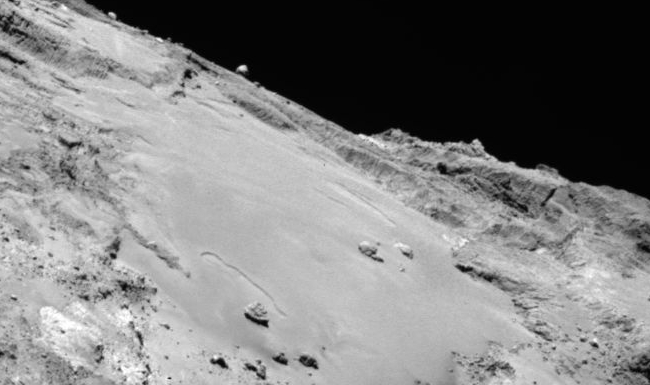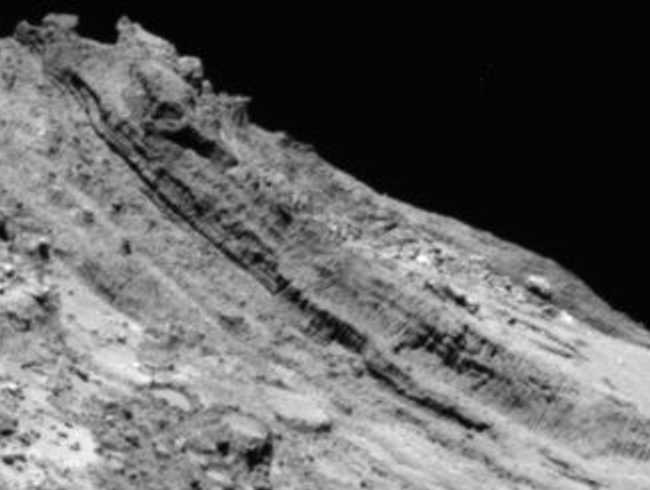Comet 67P/C-G’s active surface

Cool image time! The Rosetta science team today released a spectacular image, taken by Rosetta’s high resolution camera, of the surface of Comet 67P/C-G. A cropped version is above and below the fold. A cropped version of the full image, focusing in on the smooth and active area dubbed Imhotep, is above.
This smooth dusty terrain, which covers about 0.8 sq km, is etched with curvilinear features stretching hundreds of metres and which have been found to change in appearance over time. Many large boulders are also seen scattered within the smooth terrain, including the boulder Cheops in the foreground. Smaller but more numerous boulders are associated with exposed cliff faces and are most likely the product of erosion. In some debris falls, detailed analysis has revealed the presence of water ice.
I have also included, below the fold, a second close-up crop from this same image, showing the layered cliffs to the left of Imhotep as well as several mysterious as-yet not understood round features at the cliff’s base.

Particularly eye-catching is the distinctive layered and fractured material to the left of centre in the background. Similar patterns are also seen in the exposed cliff-like faces towards the right of the scene too, where Imhotep transitions into the Khepry region. Layers like this are seen in various locations on the comet and scientists are trying to understand how they might be related to the comet’s formation and/or evolution.
Just in front of the prominent left-hand stack of layers a number of small round features can be found. They have a well-defined rim with a smooth interior and appear slightly raised from the surrounding material. One explanation for their appearance is that they are ancient sites of active regions covered by dust and are now being revealed by varying erosion of the overlying layers.
On Christmas Eve 1968 three Americans became the first humans to visit another world. What they did to celebrate was unexpected and profound, and will be remembered throughout all human history. Genesis: the Story of Apollo 8, Robert Zimmerman's classic history of humanity's first journey to another world, tells that story, and it is now available as both an ebook and an audiobook, both with a foreword by Valerie Anders and a new introduction by Robert Zimmerman.
The print edition can be purchased at Amazon or from any other book seller. If you want an autographed copy the price is $60 for the hardback and $45 for the paperback, plus $8 shipping for each. Go here for purchasing details. The ebook is available everywhere for $5.99 (before discount) at amazon, or direct from my ebook publisher, ebookit. If you buy it from ebookit you don't support the big tech companies and the author gets a bigger cut much sooner.
The audiobook is also available at all these vendors, and is also free with a 30-day trial membership to Audible.
"Not simply about one mission, [Genesis] is also the history of America's quest for the moon... Zimmerman has done a masterful job of tying disparate events together into a solid account of one of America's greatest human triumphs."--San Antonio Express-News

Cool image time! The Rosetta science team today released a spectacular image, taken by Rosetta’s high resolution camera, of the surface of Comet 67P/C-G. A cropped version is above and below the fold. A cropped version of the full image, focusing in on the smooth and active area dubbed Imhotep, is above.
This smooth dusty terrain, which covers about 0.8 sq km, is etched with curvilinear features stretching hundreds of metres and which have been found to change in appearance over time. Many large boulders are also seen scattered within the smooth terrain, including the boulder Cheops in the foreground. Smaller but more numerous boulders are associated with exposed cliff faces and are most likely the product of erosion. In some debris falls, detailed analysis has revealed the presence of water ice.
I have also included, below the fold, a second close-up crop from this same image, showing the layered cliffs to the left of Imhotep as well as several mysterious as-yet not understood round features at the cliff’s base.

Particularly eye-catching is the distinctive layered and fractured material to the left of centre in the background. Similar patterns are also seen in the exposed cliff-like faces towards the right of the scene too, where Imhotep transitions into the Khepry region. Layers like this are seen in various locations on the comet and scientists are trying to understand how they might be related to the comet’s formation and/or evolution.
Just in front of the prominent left-hand stack of layers a number of small round features can be found. They have a well-defined rim with a smooth interior and appear slightly raised from the surrounding material. One explanation for their appearance is that they are ancient sites of active regions covered by dust and are now being revealed by varying erosion of the overlying layers.
On Christmas Eve 1968 three Americans became the first humans to visit another world. What they did to celebrate was unexpected and profound, and will be remembered throughout all human history. Genesis: the Story of Apollo 8, Robert Zimmerman's classic history of humanity's first journey to another world, tells that story, and it is now available as both an ebook and an audiobook, both with a foreword by Valerie Anders and a new introduction by Robert Zimmerman.
The print edition can be purchased at Amazon or from any other book seller. If you want an autographed copy the price is $60 for the hardback and $45 for the paperback, plus $8 shipping for each. Go here for purchasing details. The ebook is available everywhere for $5.99 (before discount) at amazon, or direct from my ebook publisher, ebookit. If you buy it from ebookit you don't support the big tech companies and the author gets a bigger cut much sooner.
The audiobook is also available at all these vendors, and is also free with a 30-day trial membership to Audible.
"Not simply about one mission, [Genesis] is also the history of America's quest for the moon... Zimmerman has done a masterful job of tying disparate events together into a solid account of one of America's greatest human triumphs."--San Antonio Express-News


It would be really nice to have a highly capable rover (or perhaps rather a hopper) that can really get close enough to better understand processes that created such a surface. Rosetta’s great and all, but so much more could be done. Too bad SLS and Orion suck up all the money while things that NASA is really great at are run on a shoestring budget.
Quite amazing that we can actually see what a comet looks like up close. One of the most under-rated benefits of human space exploration is that lights in the sky are places we can go.